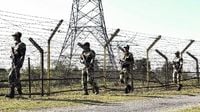In a tense escalation of hostilities, India successfully intercepted a long-range missile fired by Pakistan aimed at Delhi, marking a significant moment in the ongoing conflict between the two nations. The missile, identified as a Fatah-II, was brought down over Sirsa, Haryana, early on Saturday morning, May 10, 2025, according to government sources.
This interception comes on the heels of Pakistan's launch of "Operation Bunyan ul Marsoos," which was initiated in response to what Pakistan claims were Indian airstrikes earlier that evening. The operation has heightened tensions, with Pakistan intensifying its air operations following a series of drone attacks that targeted 26 locations across India, from Jammu and Kashmir down to Gujarat.
India's Ministry of Defence confirmed that its air defense systems thwarted multiple attacks aimed at vital installations, including airports and airbases. Despite these threats, the only injuries reported were from an attack in Ferozepur, Punjab, where some family members were hurt during the chaos.
As Pakistan ramped up its military aggression, Indian cities were placed on high alert. The Airports Authority of India (AAI) announced the temporary suspension of civil flight operations at 32 airports across northern and western India until May 25, 2025. Additionally, 25 segments of Air Traffic Service (ATS) routes within the Delhi and Mumbai Flight Information Regions were closed to civilian traffic, reflecting the serious nature of the security situation.
In a retaliatory move, India launched precision strikes targeting key locations in Pakistan, including major urban centers such as Islamabad, Lahore, and Rawalpindi. The Indian Air Force (IAF) executed airstrikes against three Pakistani airbases: Nur Khan Airbase in Rawalpindi, Rafiqi Airbase in Shorkot, and Murid Airbase in Chakwal. Reports indicate that explosions were heard at these sites, confirming the effectiveness of India's counteroffensive.
Lieutenant General Ahmad Sharif Chaudhry, the Director General of Inter-Services Public Relations (DG ISPR) for Pakistan, acknowledged the strikes, stating that Indian forces had indeed targeted the Nur Khan and Rafiqi airbases. This admission underscores the gravity of the situation as both nations grapple with the implications of their military actions.
Prior to the missile interception, Pakistan had attempted to launch drone attacks on multiple locations, which were also successfully thwarted by Indian defenses. The Indian military reported having downed around 300-400 Pakistani drones over the last few days, showcasing the effectiveness of its air defense capabilities.
The Fatah-II missile, fired by Pakistan, has a reported range of approximately 400 kilometers, indicating its potential to reach significant targets within Indian territory. The missile was intercepted around 12:15 AM, just hours after the commencement of Operation Bunyan ul Marsoos, which Pakistan claims is a strategic military initiative aimed at countering Indian actions.
In response to the missile threat, the atmosphere in Pakistani cities, particularly in Islamabad, Lahore, and Rawalpindi, has become increasingly tense. Sirens sounded throughout these urban areas as residents braced for potential further attacks, and reports of panic and confusion have surfaced as people reacted to the escalating military conflict.
The situation remains fluid, with the Indian Ministry of Defence asserting that all Indian airbases and military installations are secure. Despite the heightened tensions, officials have urged the public not to panic, stating that the situation is under control and that continuous monitoring is in place.
As the conflict unfolds, both nations are on high alert, with military operations ongoing. The international community watches closely, as the potential for further escalation looms large. The events of May 10, 2025, may mark a pivotal moment in the India-Pakistan relationship, as both sides navigate the complexities of military engagement and regional stability.
In the aftermath of these developments, analysts are considering the broader implications of Pakistan's Operation Bunyan ul Marsoos, which translates to "Operation Strong Foundation or Wall." This operation is seen as a strategic move by Pakistan to apply pressure on India from different angles, particularly following the recent military exchanges.
While the immediate threat appears to have been addressed with the successful interception of the missile and the thwarting of drone attacks, the underlying tensions between India and Pakistan remain unresolved. Both countries continue to grapple with their military strategies and the potential ramifications of their actions on regional and global peace.
As the situation evolves, it is crucial for both nations to consider diplomatic avenues to de-escalate tensions and prevent further military confrontations. The potential for conflict remains high, and the international community's role in facilitating dialogue and understanding between India and Pakistan is more important than ever.






